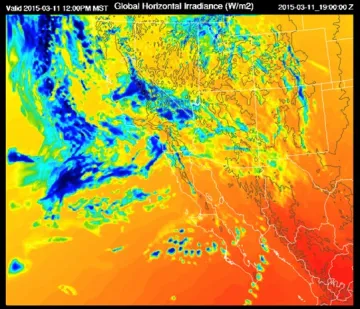
Power Forecasting Group
The UA PFG creates high-resolution weather models and power forecasts for 2.7 GW of renewable energy power in operation with electric utility companies in the Southwest. The PFG creates forecasts in multiple time frames from sub-hourly to hourly to seven days in advance for use by electric utility wholesale energy schedulers, grid operators, day-ahead energy marketers, and real-time traders. An important aspect of these forecasts is that they present not just a single forecast number, but a range of outcomes derived from multiple runs of our customized high-resolution weather model. This provides the end user with both an idea of forecast accuracy and forecast variability and power output from variable energy resources. With these functions, users of the forecast can improves energy market trading strategies, schedule more efficient generators, reduce costs, defer maintenance and optimize use of battery storage.
Learn more about the UA Power Forecasting Group
During the Arizona Summer thunderstorm season, a daily model discussion is made to end-users. This technical discussion contains a general synopsis of the general weather plus a detailed looks at model initialization accuracy as well as expected model performance. In addition, a second discussion product covers expected utility specific impacts such as rapid temperature changes for load forecasting, lightning threats, heavy rain/flash flooding, and high winds.
Listen to Mike Leuthold's Arizona WRF Discussion
Solar Forecast 2

Department of Energy's Solar Forecast 2 Project is comprised of eight different teams who have been awarded collectively $12M to advance knowledge on solar forecasting, a method designed to accurately predict the availability of solar power through weather forecasting. The University of Arizona's Power Forecasting Group lead by Assistant Research Professor, Will Holmgren, was awarded $1M to test solar forecasting models that will ultimately allow energy companies to efficiently distribute solar energy based on the weather.
"We're at a point for most utilities in the United States, where there is enough solar and wind power, that we need to think about forecasting and integrate it into their [power companies] own frameworks," said Holmgren.
His team works to make forecasting easier by navigating through the statistical challenges of unpredictable weather, creating probably forecasts that energy companies can effectively use. "To me that's the exciting part of this project and has the most payoff," said Holmgren.
